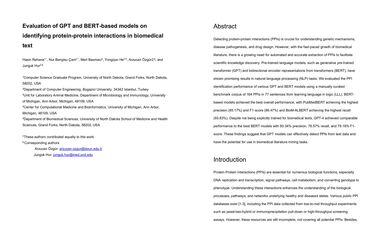Evaluation of GPT and BERT-based models on identifying protein-protein interactions in biomedical text
Detecting protein-protein interactions (PPIs) is crucial for understanding genetic mechanisms, disease pathogenesis, and drug design. However, with the fast-paced growth of biomedical literature, there is a growing need for automated and accurate extraction of PPIs to facilitate scientific knowledge discovery. Pre-trained language models, such as generative pre-trained transformers (GPT) and bidirectional encoder representations from transformers (BERT), have shown promising results in natural language processing (NLP) tasks. We evaluated the performance of PPI identification of multiple GPT and BERT models using three manually curated gold-standard corpora: Learning Language in Logic (LLL) with 164 PPIs in 77 sentences, Human Protein Reference Database with 163 PPIs in 145 sentences, and Interaction Extraction Performance Assessment with 335 PPIs in 486 sentences. BERT-based models achieved the best overall performance, with BioBERT achieving the highest recall (91.95%) and F1-score (86.84%) and PubMedBERT achieving the highest precision (85.25%). Interestingly, despite not being explicitly trained for biomedical texts, GPT-4 achieved commendable performance, comparable to the top-performing BERT models. It achieved a precision of 88.37%, a recall of 85.14%, and an F1-score of 86.49% on the LLL dataset. These results suggest that GPT models can effectively detect PPIs from text data, offering promising avenues for application in biomedical literature mining. Further research could explore how these models might be fine-tuned for even more specialized tasks within the biomedical domain.
PDF Abstract

 WebText
WebText